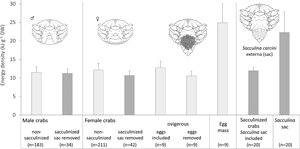Article contents
Sacculina carcini impact on energy content of the shore crab Carcinus maenas L.
Published online by Cambridge University Press: 04 August 2022
Abstract

The impact of Sacculina carcini infection on the nutritional status of the shore crab Carcinus maenas was investigated in the western Dutch Wadden Sea for a period of 20 months. About 3.3% of the population was sacculinized, i.e. externally infected with S. carcini and only 0.7% presented scars of previous infection. The results of mixed linear models showed that sacculinized and non-sacculinized crabs had similar morphometric condition, while the energy density of parasitized crabs (externa excluded) was significantly reduced by about 4.3% overall, and by up to 5.8% in crabs under 40 mm carapace width. However, when Sacculina externa was included in the energy determinations, the difference in energy density decreased to 1.2%, while total energy content of the pair infected crab-parasite including externa was 30.8% higher than non-sacculinized crabs of similar size. The total energy content of ovigerous females (eggs included) was even higher, near doubling the energy of similar-sized crabs. The same way, total energy content of Sacculina externa was about 4 times lower than total energy of egg mass. The results suggest that the rhizocephalan parasite is efficient in consuming the energy that the host may allocate for growth and maintenance, but require future studies to disentangle the impact of the degree of internal infection and the implications for the dynamics of the population.
- Type
- Research Article
- Information
- Copyright
- Copyright © The Author(s), 2022. Published by Cambridge University Press
References
- 1
- Cited by





